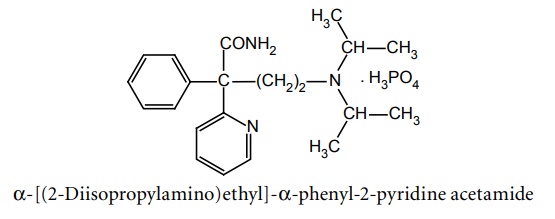Moderate to marked sodium channel blockade agents
| Home | | Medicinal Chemistry |Chapter: Medicinal Chemistry : Antiarrhythmic Drugs
Antiarrhythmic Drugs :Moderate to marked sodium channel blockade agents - Synthesis and Drug Profile - i. Quinidine Sulphate ii. Procainamide HCl (Pronestyl) iii. Disopyramide Phosphate (Norpace, Regubeat) iv. Moricizine HCl (Ethmozine) v. Tiracizine HCl - Structure, Properties, uses, Synthesis, Assay, Storage, Dosage forms, Dose
SYNTHESIS AND DRUG PROFILE
Class I: Blockade of fast sodium ion channel by depressing phase of the action potential
Mode of action: These agents block the specific channels and decrease the threshold for excitability. It decreases the conduction velocity in fast response tissues and increases QRS duration. These drugs also inhibit the triggered activity arising from delayed after depolarization (DAD) or early after depolarization (EAD) and shifts the voltage dependence of recovery from inactivation to more negative potentials, thereby tending to increase the refractioners.
Moderate to marked sodium channel blockade agents
i. Quinidine Sulphate

Metabolism: Once absorbed, quinidine is subjected to hepatic first-pass metabolism and is approximately 85% plasma protein bound, with an elimination half-life of approximately 6 h. It is metabolized mainly in the liver, and the renal excretion of unchanged drug also is significant (10%–50%). The metabolites are hydroxylated derivatives at either the quinoline ring through first-pass O-demethylation or at the quinuclidine ring through oxidation of the vinyl group. These metabolites possess only about one-third of the activity of quinidine.
Properties and uses: It exists as a white or almost white crystalline powder or silky colourless needles. It is insoluble in acetone and slightly soluble in water, but soluble in boiling water and alcohol. Quinidine is an alkaloid isolated from cinchona bark. It is dextrorotatory diastereoisomer of quinine. Quinidine is very useful for long-term treatment of ventricular premature depolarization or to prevent recurrences of ventricular tachycardia after cardioversion of this arrhythmia. Quinidine should not be used without prior digitalization. It can cause cinchonism, characterized by hearing loss, vomiting, and diarrhoea.
Assay: Dissolve the sample in acetic anhydride and titrate with 0.1 M perchloric acid, using naphtholbenzein as an indicator.
Storage: It should be stored in well-closed airtight containers and protected from light.
Dosage forms: Quinidine sulphate tablets I.P., B.P., Quinidine HCl tablets I.P., Quinidine dihydrochloride I.P., Quinidine bisulphate tablet I.P.
ii. Procainamide HCl (Pronestyl)

Synthesis

Metabolism: Metabolites of procainamide include p-amino benzoic acid and N-acetyl procainamide. The acetylated metabolite also active antiarrhythmic agent. Metabolism is catalyzed by N-acetyl transferase.
Properties and uses: It is a white crystalline powder, odourless, and soluble in water, alcohol, slightly soluble in chloroform, very slightly soluble in ether. It was developed in the course of research for compounds structurally similar to procaine. It is also more stable in water than procaine. It is useful in suppressing arrhythmias of ventricular origin. It is also effective against premature artrial contractions and artrial fibrillations. It is used in the management of myotonia. It is also used in the treatment of arrhythmias in alcohol withdrawal.
Assay: Dissolve the sample in dilute hydrochloric acid and perform the determination of primary aromatic amino-nitrogen (Diazotization method).
Storage: It should be stored in well-closed airtight containers and protected from light.
Dose: The usual dose is 3 to 6 g orally at intervals of 6 to 8 h.
Dosage forms: Procainamide injection B.P., Procainamide tablets B.P., Procainamide HCl injection I.P., Procainamide HCl tablets I.P.
iii. Disopyramide Phosphate (Norpace, Regubeat)

Synthesis

Metabolism: Half of the drug is excreted unchanged, rest of the amount undergoes hepatic metabolism to form N-dealkylated compound.
Properties and uses: It is a white or almost white powder, which is soluble in water, sparingly soluble in alcohol, and insoluble in methylene chloride. Used as an antiarrhythmic agent.
Assay: Dissolve the sample in anhydrous acetic acid and add naphtholbenzein indicator. Titrate with 0.1 M perchloric acid until the colour changes from yellow to green.
Storage: It should be stored in well-closed airtight containers and protected from light.
Dose: Total daily dose is 400–500 mg; 100–150 mg four times/day.
Dosage forms: Disopyramide phosphate capsules B.P.
iv. Moricizine HCl (Ethmozine)

Synthesis

Properties and uses: These are white crystals, which are soluble in water or alcohol. It is used in the treatment of cardiac arrhythmia.
Dose: The usual dose is 600 mg/day in three divided doses. It infrequently causes gastrointestinal and CNS effects.
v. Tiracizine HCl

Properties and uses: Tiracizine hydrocholoride is an antiarrhythmic drug reported to reduce excitability of cardiac cells through blockade of fast sodium channels.
Related Topics
